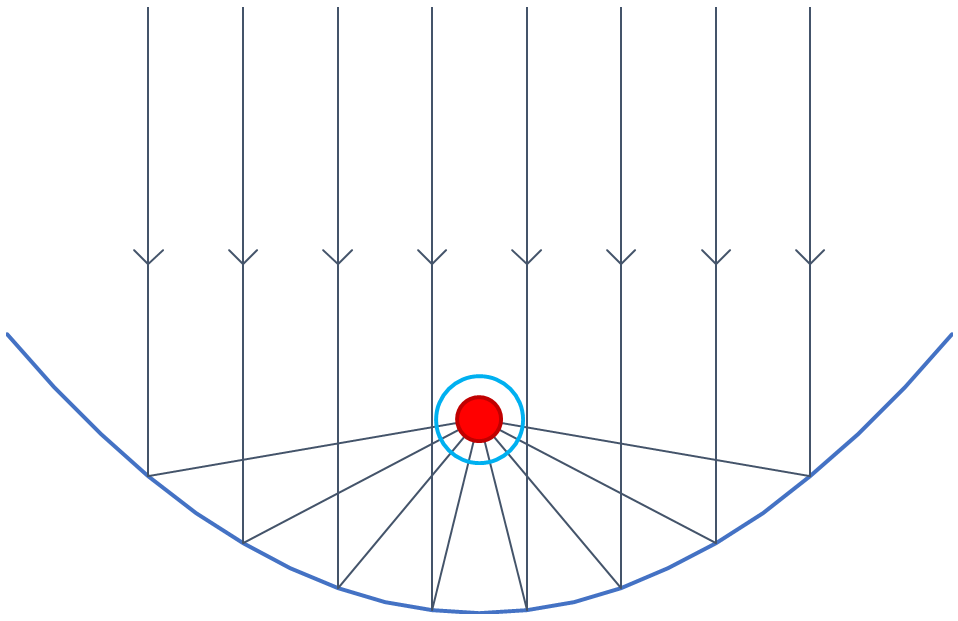Parabolic Trough Collectors
Published on 21 August 2022
Parabolic Trough Collectors (PTCs) are devices that reflects the incoming sun irradiation towards a main axis where irradiation is concentrated onto a fluid and converted into heat for further use as heat or for further conversion into (renewable) electricity.
The name of such devices comes from the shape of the reflector, either a mirror shaped as a parabolic cylinder, or a set of simpler-shaped mirrors combined to create a good approximation of a parabolic cylinder at a lower cost. The parabolic shape exploits the property of each parabola that concentrates any incoming irradiation along its symmetry axis towards its focal point. A 3D device with only parabola as cross-sections along its main axis (i.e a parabolic cylinder) therefore has a focal axis of concentrated irradiation.

Principle of sun irradiation concentration with a parabolic mirror
Circulating an appropriate fluid, called a heat transfer fluid (HTF), along this focal axis, the irradiation can be absorbed, converted into heat and transported away within the fluid. The absorption and conversion can either be performed by the fluid itself or by a material (generally a metal) in direct contact with the transfer fluid to conduct or convect such heat. Because the main function of this part of the assembly is irradiation absorption, it is called an absorber.
Efficiency of irradiation to heat conversion
Because irradiation is concentrated to locally heat up a fluid, such a fluid also experiences radiation losses towards its cooler environment. Such radiation losses are the main thermal losses during the radiation to heat conversion process because the system is designed to minimise conduction and convection losses, notably by creating a vacuum around the absorber. Heat losses from the heat transfer fluid after conversion are equivalent to a loss in conversion and are quantified by a thermal efficiency (how much heat leaves the absorber compared to how much energy reached the absorber).
The absorber and its surrounding envelope to host the vacuum occupy some volume along the path of incoming sun irradiation, thereby creating a blind spot on the parabola. This blind spot optically restricts the efficiency of irradiation concentration, which is quantified by an optical efficiency (how much irradiation is concentrated towards the absorber compared to total incoming irradiation).
Heat radiation towards the mirror is not a big concern as it could be reflected back to the absorber. However, heat radiation opposite to incoming sun light is lost. Blocking such radiation with further mirrors above the absorber is possible, but this will restrict the path of incoming sun light. There is therefore a trade-off to find between optical efficiency and thermal efficiency (as well as cost and complexity created by additional mirrors).
In existing commercial applications, optical efficiency lies between 75 and 80% and is fairly independent of operating conditions, both in terms of intensity of sun irradiation and HTF temperature.
On the other hand, the thermal efficiency of the PTC is largely dependent on the operating conditions. An increase in HTF temperature favours radiation losses and therefore decreases thermal efficiency (but largely increases heat-to-electricity conversion efficiency). An increase in intensity of sun irradiation allows an increase of HTF flow rate for an identical HTF temperature, so that the duration of heat losses from HTF is reduced and thermal efficiency increases. The thermal efficiency can therefore ranges from 50 up to 98%, with lower values at low sun irradiation and high HTF temperature and highest values at high sun irradiation and low HTF temperature.
The combination of optical and thermal efficiencies means that conversion of incoming sun energy into heat transported away by the heat transfer fluid has an efficiency of 40 to 78%.
